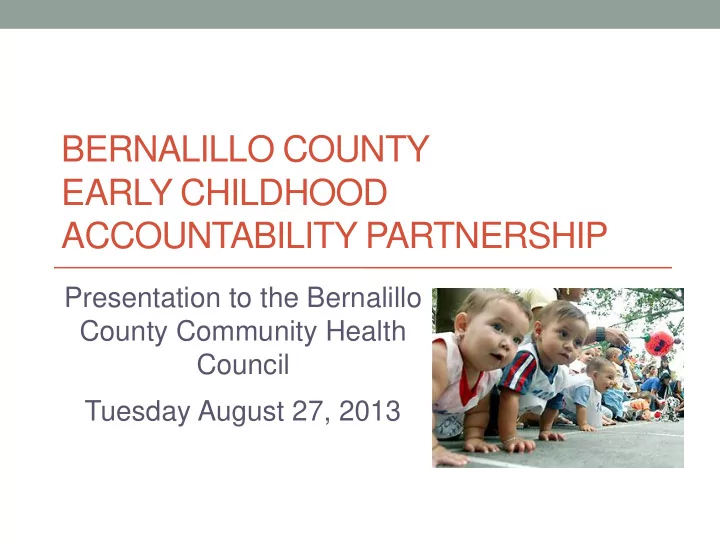

BERNALILLO COUNTY EARLY CHILDHOOD ACCOUNTABILITY PARTNERSHIP Presentation to the Bernalillo County Community Health Council Tuesday August 27, 2013
ECAP HISTORY AND BACKGROUND
Background • Place-based effort • Pregnancy to age 8 • Collective Impact Framework • Initiated in November 2010
WHAT ARE THE BIG GOALS ? To develop a common agenda with a diverse group of stake holders through a Collective Impact Framework To develop strategies that build on the strengths of our families, children and community, To be accountable to create measurable change in a specified period of time WHO ARE THE PARTNERS? ECAP membership consists of a group of leaders from different sectors who have come together to make a public commitment to achieve collective impact. .
Shared Result All Bernalillo County Children will be ready for and succeed in school.
WHAT ARE ECAP’S PRIMARY STRATEGIES? F ocus on a Single Measurable Result and Core Set of Indicators • ECAP will use Results Based Accountability processes and tools to develop a core set of indicators to measure success. Public Accountability • ECAP will ask community leaders to make a public commitment to hold themselves accountable for accelerating progress within a specific measurement period. Collaborative Leadership • ECAP will use the Leadership in Action Program (LAP) to support leaders to engage and learn a set of collaborative leadership skills and competencies that have proven successful in other cities to mobilize collective impact with accountability. Aligned Contributions • ECAP will align contributions at a scope and scale necessary to make a measureable improvement to the school readiness and success of young children in Bernalillo County.
Roadmap
Outcome Indicators: 1A.Kindergarten readiness Outcome Indicators: 3 rd 1B. 2A.College grade reading enrollment proficiency 2B. College retention 1C. 8 th 2C.Certificate or grade math degree proficiency attainment 1D. High 2D. Adult school graduation educational attainment Outcome Indicator: Outcome Indicators: 3A.Employment in a 4A. Achievement gap high-wage job in 4B. High school Bernalillo, Sandoval, graduation gap 4C. Certificate and Torrance, or Valencia County degree attainment gap
What is Collective Impact? “The commitment by a group of important actors from different sectors to a common agenda for solving a specific social problem.” Kania and Kramer, 2011
Collective Impact Requires New Ways of Working • Understand that social problems - and their solutions arise - from interaction of many organizations within larger system • Cross-sector alignment with government, nonprofit, philanthropic and corporate sectors as partners • Organizations actively coordinating their action and sharing lessons learned • All working toward the same goal and measuring the same things
12 The Five Conditions of Collective Impact 1. Common Agenda Shared vision, common understanding of the problem, and a joint approach to solving the problem. 2. Shared Measurement Collecting data to measure results on a regular basis so that participants can hold each other accountable. 3. Mutually Reinforcing Activities Coordinated, but differentiated activities among the participant organizations. 4. Continuous Communication Consistent and open communication to: build trust, assure mutual objectives, and create common motivation. 5. Backbone Support A separate organization to coordinate the overall initiative and the participating organizations. Source: Hanleybrown, Kania , & Kramer. 2012. “Channeling Change: Making Collective Impact Work.” Stanford Social Innovation Review .
13 The Three Phases of Collective Impact in Relation to ECAP (Kania and Kramer, 2011)
ECAP Committees Governance and Infrastructure Committee Organizing Committee Communications Strategic and Community Planning and Engagement Data Committee Committee
Organizing Team Members • Judy Baca - New Mexico Department of Health • Dana Bell - UNM Center for Education Policy Research • Sophie Bertrand - UNM Center for Development and Disability • Michelle Bloodworth - Apex Education • Catherine Bornhorst - Coordinator, ECAP • Vi Florez - UNM College of Education • Angelo Gonzales - Mission: Graduate , UNM College of Education • Christine Hollis - New Mexico Voices for Children • Marsha McMurray-Avila - Bernalillo County Community Health Council • Frances Varela – Varela Consulting • Lois Vermilya - UNM Family Development Program • Laurel Wyckoff - New Mexico PBS
Operational Plan • Collective Impact Framework • Phase II Implementation Goal • January 2014 • Quarterly Evaluation
Phase One Priorities • Influential Champions • Engage Early Childhood leaders and networks • Backbone Structure and Fiscal Agent • Adequate financial resources • Complete 4-month LAP Train-the-Trainer process • Align with Mission: Graduate • Early Childhood Report Card • Call to Action • Accountability Partners • Website
Accomplishments • Convenings held three times per year • Definition of School Readiness • Capacity Map • New Coordinator • Committed Organizing Team • Funding of Phase One • Fiscal Sponsor UNM Network for Educational Renewal • Committed to Mission: Graduate • Funding for LAP Facilitator Training
All Bernalillo County Children will be ready for and succeed in school. Thank You!
Recommend
More recommend